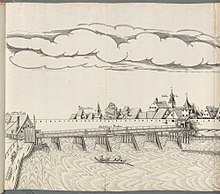Ruozan Castle Gate
The Ruozanburgtor was a gate of the Arnulfini city wall in Regensburg , which was built around 920 under Duke Arnulf I as part of a western expansion of the city.
During the construction of the Arnufini city wall around 920, the western wall of the Roman camp Castra Regina , which still existed at that time, was torn down and moved approx. 400 m to the west in order to integrate the settlements that had emerged outside the Roman wall into the city. The Arnufini city wall began on the Danube at today's St. Oswald Church , ran along today's street "Weißgerbergraben", to the confluence of the former East-West Street (today "Ludwigsstraße"). The Ruozanburgtor was built there, which led to a large square, which at that time was still the two present-day squares Arnulfsplatz and Bismarckplatzunited. The wall continued over this square, following the course of today's “Drei-Mohren-Straße” and the “Beraiterweg” over the Aegidienplatz , to the St. Emmeram monastery , which was enclosed and then ran east to the Old Emmeramer To reconnect the gate to the wall of the Roman camp. The Ruozanburgtor at the western end of today's “Ludwigstrasse” corresponded to the Hallertor at the end of today's street “Unter den Schwibbögen” at the eastern end of Ost-West-Strasse . At that time the wall of the Roman camp was still there and the eastern expansion of the city began and the Ostengasse was created.
400 years later around 1320 after the new eastern and western city expansion and the construction of the new medieval city wall that enclosed the new city district, both old city gate towers lost their importance as gates. They were converted into clock towers around 1500, called "Neue Uhr" and "Haller Uhr" and had a lasting impact on the cityscape until they were demolished in the mid-19th century.
The former Ruozanburgtor, or the clock tower “Neue Uhr” that arose from it, was later integrated into a house ensemble, consisting of a large gabled house closing the street with a barrel-vaulted narrow house passage that leads to the large square (after 1803 called “Unterer Jacobshof”, later Arnulfsplatz). This house ensemble with the clock tower was demolished in 1830 in preparation for a visit by King Ludwig I , who was to inaugurate the street that was newly named after him. The street should lead out onto Arnulfsplatz without obstructing the house and the clock tower should not obstruct the view of the facades of the town houses on Arnulfsplatz. The population welcomed the removal of the narrow and dark doorway, and the demolition of the " New Clock Tower, which was almost thicker at the top than at the bottom and also strange because of its age " was regretted. Today the houses with the house numbers Ludwigstrasse 7 and 8 can be found at the former location of the tower ensemble.
Individual evidence
- ^ Karl Bauer: Regensburg Art, Culture and Everyday History . MZ-Buchverlag in H. Gietl Verlag & Publication Service GmbH, Regenstauf 2014, ISBN 978-3-86646-300-4 , p. 408, 527, 533 .
- ^ Karl Bauer: Regensburg Art, Culture and Everyday History . MZ-Buchverlag in H. Gietl Verlag & Publication Service GmbH, Regenstauf 2014, ISBN 978-3-86646-300-4 , p. , 527, 533 .
- ^ Karl Bauer: Regensburg Art, Culture and Everyday History . 6th edition. MZ-Buchverlag in H. Gietl Verlag & Publication Service GmbH, Regenstauf 2014, ISBN 978-3-86646-300-4 , p. 311-313 .

